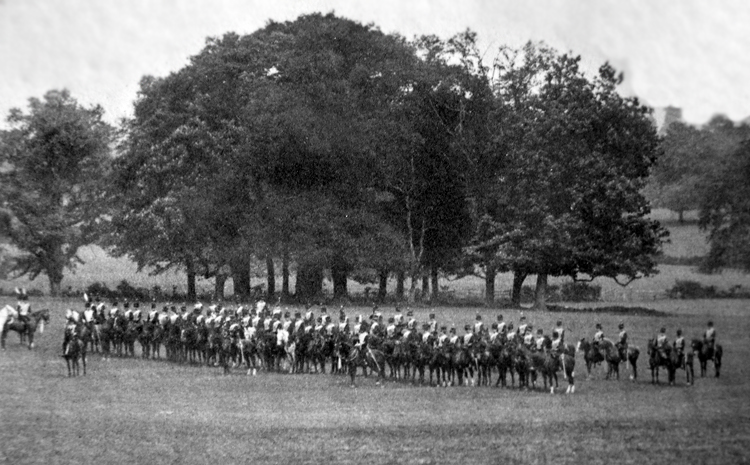
LY PAO Musical Ride c1930's

c1930's ORs crossbelt, as seen above.

LY, C Squadron at High Tor, Whitwick in August 1911. Troop
Fencing practice.

Sword vs Sword
A Dragoon (Yellow) and Lifeguard (Red) compete at the Military
Tatoo in London c1890s.
Harry Payne Postcard

Leicestershire Imperial Yeomanry at Garendon Camp 1909.

Leicestershire Imperial Yeomanry at Garendon Camp 1907, 1 man to four
horses.

Colonel F G Blair inspecting the A Squadron lines in 1905, OC
Major Muir to the Colonels left and 2ic Captain The Hon P C
Evans-Freke to the right.

Leicestershire Imperial Yeomanry at Camp 1903.

Leicestershire Imperial Yeomanry at Camp 1903.

Leicestershire Imperial Yeomanry at Camp 1903.

PAOLYC in mounted drill order circa 1899

A Troop in review order c1895.

The PAOLYC Regiment on parade at Aston camp c1890

The PAOLYC c1885, part of a print by
Simpkin.
"The 6th Yeomanry Brigade"
P.A.O Leicestershire Yeomanry Cavalry and the Derbyshire
Yeomanry Cavalry
at annual Camp (Aston) in 1890.

A PAOLYC Squadron in formation for inspection at Aston Camp.

Brigadier Col. Chandos-Pole (DYC) inspecting the Regiments at
Aston Camp 1890, the lead Squadrons of the LYC in the background
having just marched past.

Reginald W Chandos-Pole "Shandy" of the Derbyshire Yeomanry
Cavalry, a Vanity Fair Print 1888.

An LYC Squadron leader saluting the Brigadier with the
Regimental band playing in the background.

The Derbyshire Yeomanry (Dragoons) starting their march past the
Brigadier at Aston Camp. The Leicestershire having been first in
order of seniority. The Leicestershire and the Derbyshire have
had a long association culminating in their amalgamation in
1957.

A close up of the Derbyshire, note the White/Red throat plume of
the Troop Leader.

The Officer's Mess at Aston camp, with the LYC entertaining
the Ladies.

The Leicestershire & The Derbyshire Officers together.
PAOLYC Review by the Duke of Cambridge
(April 25th1885)

H.R.H. The Duke of Cambridge (1895)
The Duke of Cambridge was born in 1819, and entered the army
in 1837, with the rank of Colonel. He became Major-General
in 1845, Lieutenant-General in 1854, General in 1856, Field
Marshal in 1862. In the Crimea the Duke commanded the 1st
Division, and was present at the Alma, Balaclava and at Inkerman,
where he had his horse shot under him. In July, 1856, the
Duke was appointed Commander-in-Chief, which office he held
until October 1895. On his retirement the Duke of
Cambridge was specially appointed Chief Personnel A.D.C. to the
Queen, and Colonel-in-Chief of the Army, a distinction that will
give the Duke precedence and an ex-officio position at
all reviews and military ceremonies he may be present at.

Two PAOLYC Squadrons and the mounted band are seen in this
photograph awaiting inspection by the Duke of Cambridge.

The regiment on review by the Duke of Cambridge.

The Duke of Cambridge (right) with Colonel Baillie on the Dukes
right, the LYC RSM and duty Sergeant following.

Part of the Duke of Cambridge's contingent inspecting the
Regiment, the Hussar officer with a Shabraque is a senior
officer from another Yeomanry.


Dismounted Live firing.

A Lance Corporal of Horse (signals instructor) and Lance Corporal
(Signals qualified) of the signals troop ready for
inspection by the Duke.

OC Colonel Baillie (Centre), note the RHA Captain behind the
Colonel and how similar both uniforms are.
|